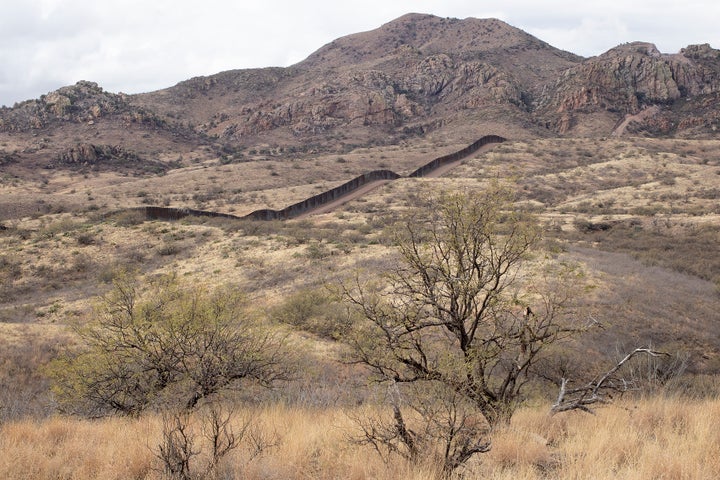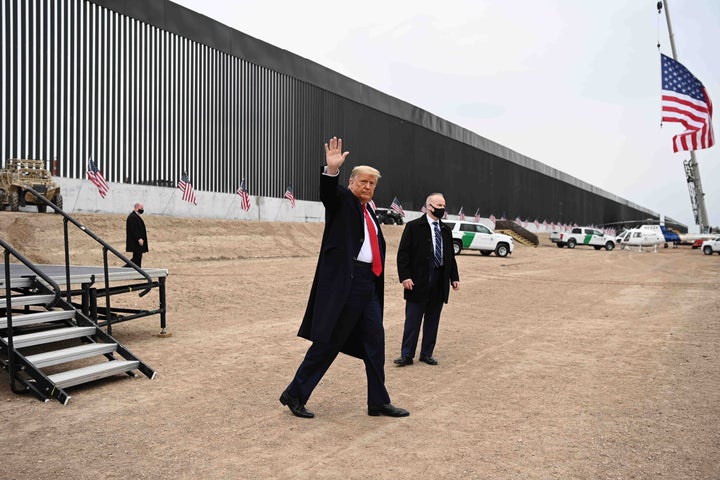Former President Donald Trump built only a fraction of the “big, beautiful” U.S.-Mexico border wall he repeatedly promised voters — but its effects, experts say, have nevertheless been “catastrophic” and far-reaching.
With Trump now out of the White House, conservationists, tribal leaders and others are hopeful President Joe Biden will take immediate action to not just halt construction but dismantle the parts of Trump’s wall that have encroached on vulnerable ecosystems and sacred lands. It remains to be seen, however, what the new president plans to do with the controversial structure.
Biden vowed in August not to build “another foot of wall” during his presidency and, on his first day in office, signed a proclamation pausing all wall construction for 60 days. But reports this month of ongoing construction along some stretches of the barrier, including in a part of Arizona designated as critical habitat for endangered jaguars, have left environmentalists and community members anxious and uncertain as to whether the president intends to keep his promise. Biden has also stayed silent as to whether he intends to take down any existing wall or what his plans are — if any — to mitigate the damage that Trump’s wall has already wreaked.

Trump promised his supporters his administration would build at least 450 miles of new barriers at the southern border by the end of 2020 but fell well short of his goal. According to a December report by U.S. Customs and Border Protection, 438 miles of “border wall system” was constructed under Trump, but of that, only about 40 miles was new primary fencing. Trump mostly replaced parts of existing wall that were outdated or in disrepair.
There’s little evidence to suggest Trump’s construction efforts — which cost billions of dollars, most of which were not authorized by Congress — had any significant impact on curtailing drug trafficking or reducing the number of undocumented migrants crossing the border, despite Trump’s insistence to the contrary.
But the wall’s construction did have drastic and detrimental consequences.
Vanda Felbab-Brown, a Brookings Institution security expert, rattled off some of those earlier this month: “Trump’s wall has been enormously environmentally destructive, depleting water sources and destroying aquifers, as well as damaging mountain landscapes and sensitive ecosystems that could take centuries to recover.”
Trump’s wall also desecrated land considered sacred to Native Americans, including destroying at least one ancient burial site using dynamite, and created a physical barrier dividing the communities of the Tohono O’odham Nation whose land straddles the border.
The wall cost ― and continues to cost ― taxpayers billions of dollars, Felbab-Brown added. “First there’s all the money that has already been sunk into it … but also the money that will go into maintenance and repair,” she said. “These are vast sums that need to be spent every few years.”
Terence Garrett, a professor of political science at the University of Texas Rio Grande Valley, agreed the effects of Trump’s wall have been “catastrophic.”
“Here’s what Trump was doing — build the fence, then ask questions,” said Garrett, whose university sits right at the U.S.-Mexico border. Garrett has written extensively about the impacts of Trump’s wall, including on private landowners and the COVID-19 pandemic. Garrett said in an August paper that Trump’s wall, coupled with his administration’s zero-tolerance immigration policies, had sparked a humanitarian crisis by stymying international cooperation and sending migrants who’d contracted the coronavirus on U.S. soil back to their home countries.

Garrett and other experts say that while Trump’s wall could have some irreparable consequences, at least some effects could be alleviated if Biden acts promptly and decisively.
A coalition composed of dozens of cities and hundreds of organizations, including tribal and environmental groups, is preparing a petition for the Biden administration that demands the removal of wall segments that have, among other things, disturbed sacred lands, destroyed sensitive wilderness areas and interfered with natural water flows.
The document, which has yet to be made public but was reviewed by HuffPost, is urging the administration to remove segments of wall in all four border states: California, Arizona, New Mexico and Texas.
The petition is also calling for all outstanding border wall contracts agreed on under the Trump administration to be canceled and for no further construction to be carried out.
Laiken Jordahl, borderlands campaigner for the Center for Biological Diversity, one of the petition’s signatories, said the coalition also wants the Biden administration to redirect the funds earmarked for the wall project to borderland communities affected by the barrier.
“We want them to use the remaining funds to revegetate areas devastated by the wall and compensate impacted tribal nations,” Jordahl said. “We desperately need to involve voices from border communities in these conversations. The Trump administration completely steamrolled our communities.”
Jordahl said hopes had initially been high that wall construction would end for good once Biden took office.
“We are breathing a sigh of relief,” he said on Feb. 8. “For the first time in years, there’s no active construction at the border.”
But less than a week later, Jordahl raised the alarm after construction appeared to have restarted in Arizona’s Pajarito Mountains, a critical part of a migration corridor for the North American jaguar, a protected species under the federal Endangered Species Act. (In 2017, Trump authorized contractors to bypass the act, among several other environmental laws, in order to get the structure built.)
Conservationists have long warned of the potentially disastrous effects that Trump’s wall could have on the jaguar, as well as dozens of other threatened and endangered species.
“These corridors have been identified by the federal government as critical for the jaguar,” Jordahl said. “If Biden doesn’t stop these walls from being built, jaguars will not recover. Their fate is in the hands of the Biden administration.”
He later added that the recent construction work appeared to be “a direct violation” of Biden’s presidential order.
When asked about the construction work, a spokeswoman for the U.S. Army Corps of Engineers told HuffPost that while “all border infrastructure projects” had been suspended “until further notice,” contractors are “still required by the terms of their contracts to maintain safe and secure job sites.” This could include securing equipment, covering or filling open trenches and providing erosion control, the spokeswoman said.
She did not specifically address the work being done in the Pajarito Mountains, but said “most of these minimum safety and security-related activities, which are designed to protect life, health and safety, will be visible to the public.”
“These activities are necessary to comply with the President’s proclamation to pause all border barrier construction,” she added.
U.S. Customs and Border Protection did not respond to HuffPost’s specific questions about the recent construction, but said in a statement that it “remains fully committed to implementing President Biden’s immigration and border security-related executive actions, including the pause of construction on the Border Wall System and adjusting its operations to enforce the proclamations related to travel and entry to the United States.”
A spokesman for the White House declined to comment as to Biden’s plans regarding the wall, including whether he intends to take down any part of it.
Whatever Biden chooses to do, it’s assured the president will face an uphill climb. Felbab-Brown said Republican lawmakers will undoubtedly push back against any proposed removal of the wall, and expensive legal battles could be waged if outstanding construction contracts are canceled. A recent Army Corps estimate said terminating these contracts could also lead to “demobilization” fees amounting to some $700 million.
“It’s important to get rid of the wall,” especially the parts of it that are on vulnerable wilderness areas and tribal lands, Felbab-Brown said. “But it might not be easy for the Biden administration to do so.”
Jordahl said he’s nonetheless hopeful that Biden will act to mitigate the impacts of the wall on borderland communities and habitats. After all, he noted, border communities in Arizona helped Biden win the election.
“Border communities have been ignored for so long ― but it seems that, finally, people across the country can see the severe amount of injustice inflicted here,” Jordahl said. “Border communities helped delivered Biden’s win here in Arizona. I think he owes it to us.”
